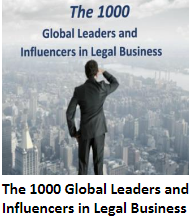Tony Williams Principal, Jomati Consultants
Tony Williams is a principal at Jomati Consultants LLP, a U.K.-based international management consulting firm for law firms, lawyers and in-house counsel that specializes in strategic expansions, reorganizations, and client strategies. Before founding Jomati Consultants, Tony was worldwide managing partner of Andersen Legal and head of its U.K. practice, where he developed the firm’s international strategy. Prior to joining Andersen Legal, Tony was managing partner of the world’s largest law firm, Clifford Chance. He was with Clifford Chance for almost 20 years and prior to his managing partner role he was a corporate partner in London, Hong Kong and the managing partner of the firm’s Moscow office. For his role in the orderly and controlled dissolution of Garretts following the Enron crisis, he was named “Partner of the Year” by The Lawyer Magazine in 2002. Tony is also a founding member of Halsbury’s Law Exchange, an independent and politically neutral legal think tank that contributes to the development of law and the legal sector.
The development of the world’s 100 largest law firms has
been quite amazing over the last 10 years and looks to be even more substantial
over the next decade.
It is, however, necessary to look at the drivers for this
growth in law firms (especially during a time of recession and subdued recovery
for most Western economies) and to consider how the market will develop further
over the next 10 years.
Traditionally, it has been thought that there were
relatively few economies of scale in a legal business. Size brought more
significant conflict issues and consumed large amounts of partner time on
“management” issues — so why the urge to become bigger?
In the last 10 years, the key drivers appear to have been:
1) Globalization;
2) The need to demonstrate U.K. and U.S. law capability;
3) The wish to build a U.S. practice; and
4) Branding and recognition.
Globalization
One of the encouraging outcomes of the financial crisis is that no country reverted to significant amounts of protectionism and that regional and bilateral trade deals continue to be made. The world is now far more interconnected than ever before. Trade, investment and know-how move relatively easily across borders. Although New York and London remain the world’s primary financial centers, others such as Singapore, Shanghai and Sao Paulo are becoming increasingly relevant. Other countries are rapidly developing. Most of the world’s megacities are now in the developing rather than developed world. Big acquisitions, funding and disputes no longer necessarily need to pass through New York or London. Some of the world’s largest country funds are based in Asia and the Middle East, recycling either commodity income or pensions savings into the global equities, bonds and real estate markets.
While
trade and investment flows have increased and become more diverse, it is
important to note that the corporate giants of today are no longer the monopoly
of the U.S. and Europe. Indeed, very soon, corporations from these countries
will be a minority in the Fortune Global 500.
Many firms, when given a choice, would often prefer not to
establish outside their home jurisdiction, but the growth potential of new
markets and the need to defend their existing client relationships from firms
with a more international footprint (which will seek to work for the client
abroad and then bring the relationship home) has left many firms with little
choice but to consider some level of international development.
Unfortunately, the cost of developing an international
practice, especially in mature and competitive markets like those in Europe and
Asia, is high. Many international firms have been established in locations such
as Hong Kong and Singapore for more than 30 years. They are now an established
part of the local business community. A new entrant will often struggle to hire
the right quality talent, and to demonstrate a service offering that is
credible in the market and positively differentiated from incumbent firms.
Given the subdued recovery in Western markets with PEP still, in real terms,
below its 2007 and 2008 highs, any investments inevitably receive close
scrutiny by partners. Accordingly, the investment pot is limited and needs to
be spent wisely and strategically. It is for this reason that firms have
increasingly been considering mergers or large team hires as a quicker,
potentially cheaper and more effective means of achieving a credible
international presence in a relatively short period of time.
While a merger may have certain advantages, it is not an
easy or risk-free option. The number of firms in a particular market with the
right client mix, practice profile, compatible culture and comparable economies
will be limited. Care and time will be needed to achieve the right deal. Law
firm mergers are not for speed daters.
It is against this context, where firms see the need for an international platform but find the range of compatible firms for a full merger limited, that the use of the Swiss verein and similar structures has emerged. With this structure, the firms come together under a global brand; however, the member firms, their management and financial performance are independent. Some firms appear to be using this structure on a short-term basis before achieving de facto full financial, management, and practice integration, as in the case of Hogan Lovells, while others appear to be using this structure as a long-term business model, as in the case of Dentons and Norton Rose Fulbright. Whatever the structural choice, the challenge is for any firm to integrate its offering so that it can present the right level of capability to its clients where it is needed, provide an efficient and effectively coordinated service while meeting the client’s expectations as to pricing, and delivering a credible return to the firm’s partners. This is a tall order.
The Development of a U.S. and U.K. Law
Capability
Despite the emergence of other new business and financial centers, English and New York law currently govern an overwhelming majority of cross-border transactions, financings, and disputes. Any firm seriously wanting to work on higher-value international transactions will need to demonstrate either a credible capability to work under English or New York law firms, or choose an effective relationship with other law firms so that the client receives as seamless a service as possible. This has been the key driver for U.S. firms to develop in London. In the U.K., more than 5,000 lawyers work in U.S.-headquartered law firms, which is a clear demonstration of the impact of U.S. firms in the market. Some U.S. firms have performed extremely well in London and have developed top-tier practices, but others have struggled to make an impact in what is one of the most competitive legal markets in the world. The progress of U.K. firms in the U.S. had been more mixed, with Clifford Chance’s troubled merger with Rogers & Wells in 2000 probably being the most high-profile move into New York.
However,
the big four U.K. firms — Allen & Overy, Clifford Chance, Freshfields, and
Linklaters — now seem to be making effective progress in the U.S., although
they now recognize that this will be a difficult market to crack. The Hogan
& Hartson and Lovells merger in 2010 to create Hogan Lovells appears to be
working well, although Hogan & Hartson was not a primarily New York-focused
firm.
The U.S. is the world’s biggest, most diverse, and most profitable market for legal services. Various estimates attribute between 40 percent and 50 percent of external legal spend occurring in the U.S. Even the financial crisis and the emergence of developing markets do not appear to be threatening the primacy of the U.S. legal market. Indeed, the litigious nature of U.S. society and the new, post-crisis assertiveness (or rapacity, depending on your views) of U.S. regulators has helped U.S. firms to exceed pre-crisis levels of revenue (although not necessarily in real terms). As a result, many U.S. firms rightly see the U.S. as a primary market for development. The U.S. legal market is not just about New York. Washington D.C., Chicago, Atlanta, Houston, Boston, Los Angeles, and San Francisco, to name but a few, are all major centers of legal services, and many would probably rank in the top 10 cities of the world in terms of legal spend.
Our strategic alliance partners, Altman Weil, track mergers
involving U.S. firms[2] and 2012,
2013, and 2014 were the three most active years ever in terms of U.S.-related
law firm mergers. This is no surprise, as firms have been seeking to develop
the depth and breadth of practice across the key U.S. markets. Some of these
mergers have or will create $1 billion or $2 billion firms in their own right.
The U.S. as a whole is still a relatively fragmented market, but if this merger
trend continues over the next few years, a far smaller group of truly national
firms will emerge, operating at different levels in the market. It has to be
appreciated that once these mergers are integrated, it can be expected that
many of these firms will use their size and financial strength to build even
more significant international practices, either by further mergers, team
hires, lateral additions, or Greenfield openings.
Branding and Recognition
Many firms have established strong reputations in their local markets, regionally, or internationally for particular types of work. Outside the legal community, however, it is often surprising how little recognition there is in the wider business world of law firm names and what they do. In global branding surveys, law firms tend to rank quite low and often a few hundred places below the Big Four accounting firms. Some would counter that this does not matter, provided that they are known and recognized by their current and future clients, and to some extent this is correct. However, in an era of national, regional, and global consolidation, branding will assume greater significance. General counsel are increasingly reviewing their law firm relationships and tending to significantly reduce the number of law firms they use both nationally and internationally. This is increasingly important to law firms, as if they “miss the cut” on a panel review they risk being excluded from future work for that client.
Probably the most comprehensive research done into legal brands is undertaken by Acritas. Its 2014 global brands survey illustrated the following.
Acritas
Global Elite Law Firm Brand Index 2014[3]
Clearly many firms will argue with the position of specific
firms in the table, but it needs to be appreciated that these are based on
global responses, not just a handful of business centers. It is also notable
that there is a direct correlation between the size and breadth of a firm, and
its level of global brand recognition. To some extent, in branding terms,
bigger really is better. While individual tables may be contentious, firms
should not lose track of the fact that their wider reputation is important.
Name recognition in the boardroom (which may be thousands of miles away from
the law firm’s head office), credibility with key regulators, acceptance by
investment banks, and name awareness by key shareholder groups can be important
factors in a law firm’s ability to win and keep work from a client.
Really Global?
Despite
the trends mentioned above and the development of $1 billion and $2 billion law
firms, it is questionable as to how close w are to the creation of truly
global law firms. The $1 billion firms are dominated by U.S.- or
U.K.-originated firms, with King & Wood Mallesons being the honorable
exception. Indeed, of the Global 100 firms, only seven do not have a major U.K.
or U.S. presence, and all of these are ranked 80 or below in the Global 100.
This is understandable, given that the U.S. and U.K. are the two largest legal
markets in the world. Of the 30 law firms with revenues more than $1 billion,
in 2013 only 11 had more than half of their lawyers outside their home country
and nine (all from the U.S.) had fewer than 25 percent of their lawyers based
outside their home country. In part this reflects the depth and maturity of the
U.S. legal market, but, given the global dispersion of GDP and the growth rates
achieved in developing markets, it is probably fair to say that firms with say
less than half of their lawyers outside their home market are not truly
developing a global capability. Of course, many firms will not want to develop
a global capability — and for good reason. If you are highly placed in a major
business and financial center running a very profitable law firm, then
investment outside your home city (even into your home country) is likely to be
expensive and ultimately dilutive of firm profitability. Spending money to lose
money is not a great investment decision. For this reason, many of the most
profitable firms in major markets (especially New York) will take a rather
jaundiced view of international expansion and only make any such investments
when they need to do so in order to protect their major investment bank and
other key client relationships. Even then they will (probably rightly) build
the smallest international outpost that is acceptable to those clients. It is
partly for this reason and differential profitability, culture and control
issues that we have never seen a truly top-tier combination between a U.K. and
U.S. law firm.
The
different approaches taken by different firms means, for perfectly
understandable reasons, that neither the global legal market nor the firms
inhabiting it will, or will need to, develop in a consistent way. Firms will
identify their own markets. Some will succeed and some will fail, but so be it.
The diversity of the business models in the legal sector enhances creativity
and client choice, so even as the global legal market develops, firms are
unlikely to be fixed with purely binary choices.
In an era of larger law firms, whether with multiple offices in the home country and/or a significant international presence, the challenge of leading and managing such firms become more challenging and time consuming. No longer will the partners come from the same cultural, educational, or ethnic background. Language issues will inhibit communication. The sheer size of the firm will mean that partners will not know one another well or at all. The scope for misunderstanding and inappropriate behavior is compounded as a firm gets larger and more diverse both geographically and culturally. Defining a firm’s culture and the glue that holds the partners together becomes more complex.
In many ways the most important issue for a leader in these
circumstances is to know when to let go and to realize that firms of that size
and complexity, often operating in different time zones, cannot be
micromanaged. Leaders of offices, practices, client teams and sectors need to
be empowered and given clear responsibility for the effective performance of
their team. They certainly need to be held accountable by the firm’s
leadership, but not second-guessed or required to seek approval for every minor
decision. This is difficult, as the pool of real leaders in a firm is often
limited. Training and mentoring may be necessary, as certainly will be
succession planning.
The firm’s leaders need to paint a clear vision for the
firm and devise its strategy. They should be visible inside and outside of the
firm. Furthermore, they must understand the issues the firm’s clients are
facing, and have a good grasp of the firm’s financial performance and key
metrics. The balance between being decisive or dictatorial needs to be
achieved.
As firms have been growing both organically and by merger,
especially in a subdued trading environment, the interpersonal skills,
communication skills, empathy and sheer stamina of the leadership team is
increasingly a determinant of the success of the firm. Some leaders have been
found wanting.
As firms become more diverse, effective communication to and from leadership, among offices, and at a purely personal level becomes more difficult. A default to email can depersonalize relationships. It can also result in a leadership group permanently being on “transmit” mode rather than ensuring that they “receive” key insights and constructive challenges from their colleagues.
Communication challenges are compounded by language and cultural sensitivities. Even “yes” can have many different messages:
The Seven Meanings of Yes
§
Yes,
I hear you
§
Yes,
I understand you
§
Yes,
I understand you and will do as you ask
§
Yes,
I understand you but will do nothing
§
Yes,
I understand you but will do the opposite
§
Yes,
I understand you, but I will speak to others to try to get you overruled
§
Yes, I understand you, but I dislike you and
will try to do this in a way that makes you look bad
.
Considerable effort is required to ensure that every issue is not seen through the lens of “head office.” No one location is the source of all wisdom, whatever those based there may think. Indeed, it is by welcoming and harnessing diverse views and experiences that a firm is able to give the best service to its increasingly multinational and multicultural clients.
The Future
We are only partway through the process of developing truly
global firms and the segmentation of the global market by types of work, target
clients, service offering, price, and profitability.
It is likely that over the next five years the number of $1
billion firms will increase by organic growth and merger to 40 or perhaps 50
firms. In the medium term, U.S.- and U.K.-based firms will dominate this end of
the market, but we may see more Australian, Continental European, Canadian,
ASEAN, and Chinese firms taking a leading role in the creation of larger and
more geographically diverse firms. After the initial phase of development, it
is likely that we will see mergers within the top 50 firms that will create
truly global firms and an increasing segmentation of the international legal
market into firms of different types, e.g., capital markets “bet the farm”
firms, high-value firms, upper-mid-tier firms, wide coverage firms, mid-tier
firms, and process organizations (the precise categories have yet to emerge,
and currently the classification of specific firms and their position in the
market is in a state of flux). A firm’s branding and what it stands for will
become increasingly relevant as this process develops. It is not inconceivable
that by 2020 or shortly thereafter we will see a $5 billion law firm.
For
those who think this is impossible, it is important to appreciate that a $5
billion law firm will have a market share of less than 1 percent of the global
legal market at that time. It also needs to be appreciated that new entrants of
the sort allowed in Australia and the U.K. and being considered in other
countries are likely to make the Global 100 list. Indeed, PWC, KPMG, and EY all
have alternative business structure licenses in the U.K., so they can offer
legal services there. They have made no secret of their wish to expand their
legal services offerings, especially when bundled with their other services so
that they can provide “business solutions.” It should be remembered that in
2001 Andersen Legal was the ninth-largest law firm in the world by revenue, but
it crashed in 2002 when Arthur Andersen collapsed in the wake of the Enron
scandal. The Big Four may make mistakes, but they are impressive organizations
with client relationships and investment capabilities that most law firms can
only dream of. To put them in context, the revenue of the three largest Big
Four accounting firms, in aggregate, exceeds the aggregate revenues of the
Global 100 law firms.
This
analysis assumes a “business as usual” approach. The impact of pricing
pressure, new working methods, and AI (artificial intelligence) on law firms
could be massive if law firm clients consistently demand change (and despite
what law firms may think, general counsel have generally been pretty benign
buyers). This could fundamentally transform the market, especially at the mid-
and lower tiers of the segmentation. This inevitably will produce winners and
losers, and some may be both at different times (consider the fortunes of
Apple, Blackberry, and Nokia over the last 20 years).
Absent
some cataclysmic event, globalization is likely to continue. Firms will need to
map their own course in order to stay relevant to their clients and to carve
out a clear position in their chosen market. The market will be dynamic. The
Global 100 firms will have revenues more than $100 billion, possibly moving
toward $200 billion. The global top 50 will probably be stronger and more
diverse than the next 50. Some will shun the global approach; others may
develop a more regional role, e.g., ASEAN. New entrants will join the rankings.
Never has there been a more interesting yet more demanding time to lead a
Global 100 law firm.
[1] FORTUNE GLOBAL 500, http://fortune.com/global500.

 Software
Software Law
Law Legal
Legal






